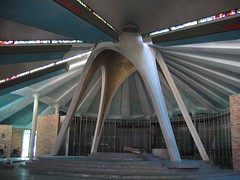Churches as augurs of revitalization
 Pre-demolition activity, St. Frances Cabrini Church in New Orleans. Photo by David Gregor.
Pre-demolition activity, St. Frances Cabrini Church in New Orleans. Photo by David Gregor.Because I am often so negative about churches in the inner city--because too often they are empire builders of land holdings, and find that improving the area around their churches increases demand and therefore prices of property, so they don't expend efforts in improvement, plus rather than create transportation plans many churches buy residential property with the intent to let it rot and replace it with parking lots--if a church is truly committed to social justice, it can be a great partner and proponent of revitalization.
(That means when the Archdiocese of Detroit agreed to sell church parishes to the City of Detroit for an eminent domain matter that condemned the Poletown neighborhood to oblivion--when a parking structure could have provided the parking the industrial plant was seeking--would likely not be considered an act of "social justice." Same probably with the Catholic Church and the demolition of the Rochambeau Building on Charles Street in Baltimore, to be replaced by a prayer garden.)
In Cleveland, the Catholic-based Famicos Foundation does some of the most difficult neighborhood rehabilitation and stabilization work around. (Also see this case study.)
In Chicago, Bethel New Life Ministries is a case study example of the power of the asset-based community development approach. (Also see this case study about their health care work.)
In Jamaica, in the Queens borough of New York City, Rev. Floyd Flake's Greater Allen A. M. E. Cathedral has worked to great effect to stabilize and rebuild the once distressed neighborhood where it is located.
In DC, the Luther Place Memorial Church has done a wide variety of incredible things in terms of assisting the homeless; the Church has built a goodly amount of housing with structured assistance programs in the vicinity of Thomas Circle.
Of course, there are many many other examples.
Yesterday, the New York Times "weighed in" on the Cabrini Church issue in New Orleans, where a group of parishioners and preservationists are fighting the demolition of this Church, which is a great example of a modernist building, in part a response and leading the social justice movement within the Church that culminated in the Vatican II reforms of 1968.
The article, "In Tale of Church vs. School, a New Orleans Dilemma," focuses more on the Gentilly residents, who favor the demolition. And they appear to fail to see the value in heritage as the building blocks of healthy neighborhoods.
But this letter to the editor appeared in the New Orleans Times-Picayune, "Churches spur recovery," (thanks to Karen Gadbois for forwarding it), and it forces us to reconsider the various levers that can bring about neighborhood recovery in especially difficult times.
Vincent B. Liberto of Metairie writes:
In regard to Katrina recovery, is it just a coincidence that in areas where pastors (perhaps most noticeably Catholic pastors) were allowed to go in and start rebuilding almost immediately, the rest of the community followed and recovery is now well under way?
Is it just a coincidence that in those areas where pastors are just beginning to get back, those communities are still floundering -- way behind of the rest of the city in recovery? Interesting, isn't it?
Think about it. Some of the best and quickest development has happened in those parts of town where churches had pastors back as soon as possible, regardless of the degree of destruction. It shows, I think, the influence one good religious leader can have on a community and neighborhood.
Wouldn't it have been great to have had them all back in their churches, whatever the churches' condition, sooner?
Index Keywords: New-Orleans; urban-revitalization



0 Comments:
Post a Comment
<< Home